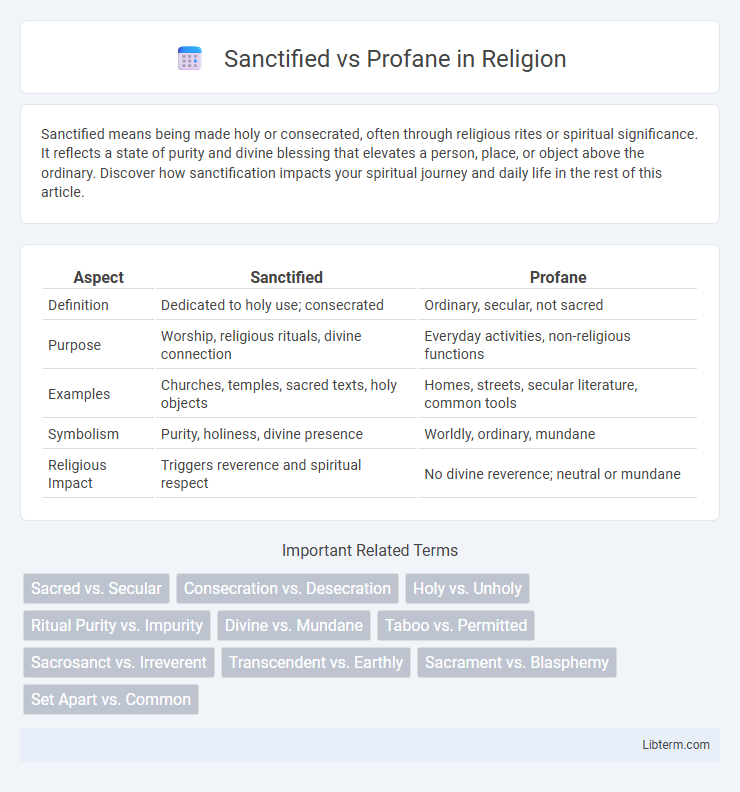Sanctified means being made holy or consecrated, often through religious rites or spiritual significance. It reflects a state of purity and divine blessing that elevates a person, place, or object above the ordinary. Discover how sanctification impacts your spiritual journey and daily life in the rest of this article.
Table of Comparison
| Aspect | Sanctified | Profane |
|---|---|---|
| Definition | Dedicated to holy use; consecrated | Ordinary, secular, not sacred |
| Purpose | Worship, religious rituals, divine connection | Everyday activities, non-religious functions |
| Examples | Churches, temples, sacred texts, holy objects | Homes, streets, secular literature, common tools |
| Symbolism | Purity, holiness, divine presence | Worldly, ordinary, mundane |
| Religious Impact | Triggers reverence and spiritual respect | No divine reverence; neutral or mundane |
Understanding the Concepts: Sanctified and Profane
Sanctified refers to something deemed holy, set apart for religious purposes, or spiritually pure, often associated with sacred rituals and spaces. Profane denotes what is secular, ordinary, or irreverent, lacking sacred significance and sometimes considered disrespectful to the sacred. Understanding these concepts involves recognizing the cultural and religious distinctions that define what is revered and what is mundane or taboo within various belief systems.
Historical Origins of Sanctity and Profanity
The historical origins of sanctity and profanity trace back to ancient civilizations where sacred spaces and objects were distinguished from ordinary or taboo elements through ritualistic practices and cultural norms. Early societies often defined the sanctified as aspects connected to divine or spiritual power, while the profane encompassed everyday, secular, or impure elements that violated sacred laws. These distinctions evolved through religious doctrines and legal codes, deeply influencing social structures and moral frameworks across cultures.
The Role of Religion in Defining the Sacred and the Profane
Religion plays a crucial role in defining the sacred and the profane by establishing boundaries between what is considered holy and mundane. Sacred elements are often imbued with divine significance, rituals, and symbols that set them apart from everyday profane experiences. These distinctions shape communal values, social norms, and individual behaviors within religious traditions.
Societal Impact: How Sanctified and Profane Shape Culture
Sanctified and profane elements profoundly influence societal norms and cultural identity by delineating what communities hold sacred versus ordinary or taboo. This dichotomy shapes rituals, moral codes, and collective behaviors that reinforce social cohesion and group belonging. Understanding these distinctions helps reveal the symbolic frameworks underpinning cultural practices and institutional structures across different societies.
Philosophical Perspectives on Sanctification and Profanity
Philosophical perspectives on sanctification and profanity explore the intrinsic nature of purity and impurity as constructs defining human experience and moral frameworks. Sanctification often symbolizes the transcendence of the mundane, representing a state of spiritual elevation or moral excellence, while profanity denotes the desecration or violation of what is considered sacred, reflecting societal taboos and cultural boundaries. These concepts are analyzed through existential, phenomenological, and ethical lenses to understand their impact on identity, communal values, and the human quest for meaning.
Rituals and Symbols: Differentiating the Sacred from the Profane
Rituals and symbols serve as primary markers differentiating the sanctified from the profane by imbuing objects or actions with sacred meaning through repeated, culturally significant practices. Sacred rituals often involve ceremonial gestures, chants, or offerings that reinforce communal identity and spiritual connection, whereas profane actions lack this symbolic sanctity and are rooted in everyday secular life. The contrast between these domains manifests in the reverence afforded to sacred symbols like totems, altars, or religious icons, which transcend ordinary experience and embody divine presence or moral order.
Modern Interpretations: Sanctity and Profanity in Contemporary Society
Modern interpretations of sanctity emphasize personal spirituality and ethical living rather than traditional religious rituals, reflecting a shift toward individualized sacred experiences. Contemporary society often views profanity not only as linguistic taboo but also as cultural resistance or social boundary-setting. This evolving understanding highlights the fluidity of what is considered sacred or profane, influenced by diverse cultural and social contexts.
Psychological Implications of the Sacred-Prophane Dichotomy
The psychological implications of the sacred-profane dichotomy reveal profound effects on identity formation and social cohesion, where sacred elements often symbolize unity, meaning, and moral order. Experiences classified as sacred can evoke transcendent emotions such as awe, reverence, and sanctity, contributing to individual well-being and resilience against existential anxieties. Conversely, encounters labeled profane may induce feelings of alienation or detachment, highlighting the dichotomy's role in shaping cognitive frameworks and emotional responses within cultural contexts.
Conflict and Harmony: When Sanctified Meets Profane
Conflict arises when sanctified ideals confront profane realities, exposing tensions between sacred values and secular practices. Harmony emerges through dialogue that respects spiritual significance while embracing everyday life, fostering mutual understanding. This balance enables coexistence where sacred beliefs inform ethical behavior without dismissing practical human experience.
Reclaiming and Redefining: Evolving Boundaries of the Sacred and Profane
Reclaiming and redefining the boundaries of the sacred and profane involves challenging traditional dichotomies and exploring how cultural, religious, and social contexts transform meanings over time. The evolving interplay between sanctified spaces and profane experiences reflects dynamic negotiations of power, identity, and spirituality in contemporary society. This process highlights how what is deemed sacred or profane is continuously contested, reclaimed, and reshaped to address evolving human values and collective memory.
Sanctified Infographic

 libterm.com
libterm.com